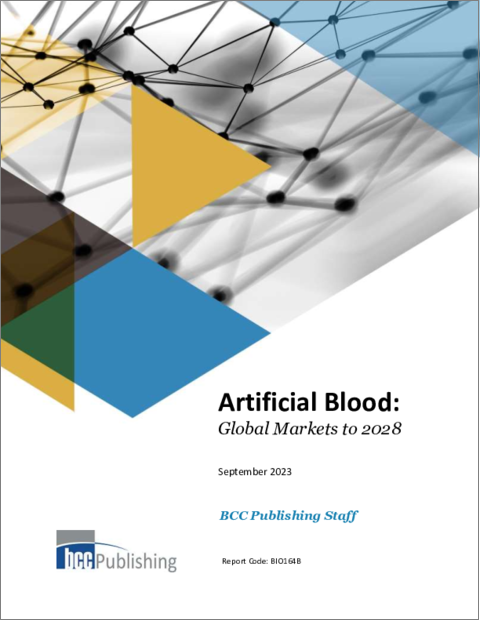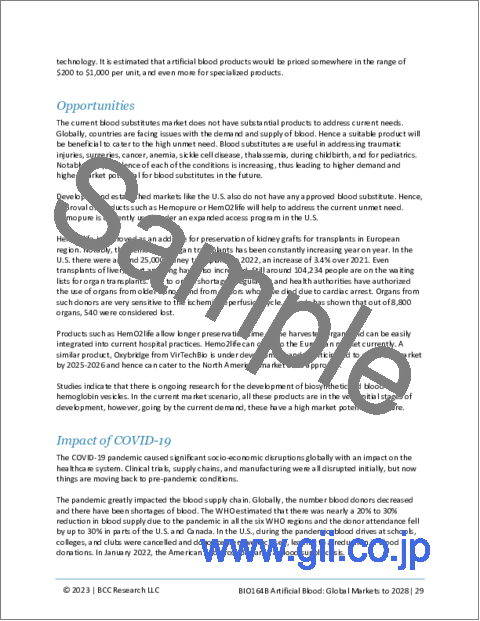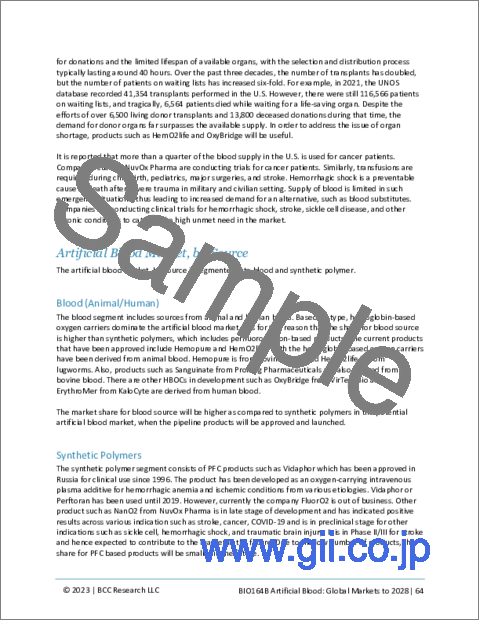|
|
市場調査レポート
商品コード
1341913
人工血液の世界市場 (~2028年)Artificial Blood: Global Markets to 2028 |
||||||
|
|||||||
| 人工血液の世界市場 (~2028年) |
|
出版日: 2023年08月29日
発行: BCC Research
ページ情報: 英文 120 Pages
納期: 即納可能
|
- 全表示
- 概要
- 図表
- 目次
世界の人工血液の市場規模は、2022年の2,390万米ドル、2023年の2,610万米ドルから、予測期間中は9.2%のCAGRで推移し、2028年には4,050万米ドルの規模に成長すると予測されています。
当レポートでは、世界の人工血液の市場を調査し、市場概要、市場影響因子および市場機会の分析、市場規模の推移・予測、各種区分・地域別の詳細分析、製品分析、技術・特許の動向、競合情勢、主要企業のプロファイルなどをまとめています。
目次
第1章 イントロダクション
第2章 サマリー・ハイライト
第3章 市場概要
- 人間の血液の問題
- 人工血液に対する新たなニーズ
- 人工血液:感染症リスクへの対処に有用
- 人工血液:ドナーの血液供給の負荷を軽減
- 人工血液:血液システムの予期せぬ需要への対処に必要
- 人工血液製剤開発のハードル
- 人工血液の理想的な特性
- 人間の血液に勝る人工血液
- 用途
- 手術
- 緊急蘇生
- 短期使用
- 人間の血液よりも効果的なケース
- 宗教的信念による拒否
- 人工血液開発における課題
第4章 市場力学
- 促進要因
- 輸血需要の増加
- 輸血に伴うリスクと課題
- 血液供給の不足
- 障壁
- 製品承認率が低い
- 製品の受け入れ
- 製品の価格設定
- 機会
- COVID-19の影響
第5章 人工血液:供給源別
- 人間の血液から開発された人工血液
- 動物の血液から開発された人工血液
- 遺伝子組み換え技術を利用して開発された人工血液
- 表面修飾ヘモグロビン
- 架橋ヘモグロビン
- 重合ヘモグロビン
- カプセル化
- 遺伝子操作された組換えヘモグロビン
- 天然ヘモグロビン
第6章 人工血液:タイプ別
- パーフルオロカーボンエマルジョン
- パーフルオロカーボンの一般的な特性
- 乳剤の選択
- パーフルオロカーボンエマルションの歴史的発展
- 第1世代PFC
- 第2世代PFC
- 第3世代PFC
- ヘモグロビンベース酸素運搬体 (HBOC)
- HBOCの一般的な特徴
- 歴史的出来事:ヘモグロビン溶液
第7章 市場推計
- 人工血液の潜在的市場
- 人工血液市場:供給源別
- 血液 (動物/人間)
- 合成ポリマー
- 人工血液市場:タイプ別
- ヘモグロビンベース酸素運搬体
- パーフルオロカーボン製品
- 人工血液市場:地域別
- 北米
- 欧州
- 新興市場
第8章 新たな技術と開発
- 概要
- 新技術
- ナノカプセル技術
- 幹細胞
- 血液代替品に関するその他の進行中の研究
第9章 製品分析
- 製品の安全性
- 製品の有効性
- 製品原価
- 法的影響
- 開発中の一部製品の製品分析
- Hemopure
- HemO2life
- HemoTech
- NanO2 (DDFPe)
- Sanguinate
- Vidaphor
- 臨床試験
- 前臨床および初期フェーズI段階の一部の製品の説明
- ErythroMer
- Hemoglobin vesicles
- OxyVita
- OxyBridge
第10章 特許分析
- FDA規制
- FDAの適正製造基準・報告
- 特許分析
第11章 競合情報
- 戦略的展開
- 競合分析
第12章 企業プロファイル
- AURUM BIOSCIENCES
- ERYPHARM
- HEMOGLOBIN OXYGEN THERAPEUTICS LLC.
- HEMARINA
- KALOCYTE INC.
- NANO SANGUIS S.A
- NUVOX PHARMA LLC.
- PROLONG PHARMACEUTICALS, LLC
- RED C BIOTECH
- VIRTECH BIO
List of Tables
- Summary Table : Global Market for Artificial Blood, Through 2028
- Table 1 : Historical Events Related to Blood Transfusion, 1628-2022
- Table 2 : Potential Benefits and Application Areas of Artificial Blood
- Table 3 : Average Number of Blood Units Required During Particular Medical Conditions
- Table 4 : The Challenges Associated with the Development of Artificial Blood
- Table 5 : Common Challenges to the Blood Transfusion Continuum in LMICs.
- Table 6 : Sources of Hemoglobin Molecules Used to Prepare Free Hemoglobin Solutions
- Table 7 : Pros and Cons of Artificial Blood Developed from Human Blood
- Table 8 : Pros and Cons of Artificial Blood Developed from Animal Blood
- Table 9 : Pros and Cons of Artificial Blood Developed from Recombinant Blood
- Table 10 : Summary of Acellular Hb-Based Oxygen Carriers
- Table 11 : Examples of Hemoglobin-based Oxygen Carrier Products and Approval Status
- Table 12 : Potential Clinical Applications of Oxygen Carriers
- Table 13 : Composition of PFC Emulsion-Based Artificial Blood Products
- Table 14 : First Generation Perfluorocarbon Emulsions Used in Medicine and Biology
- Table 15 : Comparative Study of Second-Generation PFCs
- Table 16 : PFC Emulsion Products and Current Status
- Table 17 : Comparative Study Between RBCs and HBOCs
- Table 18 : HBOC Solutions Transfusion: Side Effects and Possible Causes
- Table 19 : Examples of HBOC Products Developed, by Various Companies
- Table 20 : Global Market for Artificial Blood, Through 2028
- Table 21 : Current Cell Sources and Strategies for Ex-vivo RBC Generation
- Table 22 : List of Discontinued Blood Substitutes
- Table 23 : Hemopure: Raw Material and Method Overview
- Table 24 : Hemopure: Product Characteristics
- Table 25 : Hemopure: Advantages and Disadvantages
- Table 26 : Summary of Clinical Trials of Hemopure (HBOC-201), 2023
- Table 27 : HemO2life: Raw Material and Method
- Table 28 : HemO2life: Advantages and Disadvantages
- Table 29 : HemO2life: Product
- Table 30 : Ex vivo, In vivo and Clinical Studies involving HemO2life (M101) Use
- Table 31 : Hemotech: Raw Material and Method Overview
- Table 32 : HemoTech: Advantages and Disadvantages
- Table 33 : NanO2 (DDFPe): Raw Material and Method Overview
- Table 34 : NanO2 (DDFPe): Advantages and Disadvantages
- Table 35 : NanO2 (DDFPe): Clinical Trials, 2023
- Table 36 : Sanguinate: Raw Material and Method Overview
- Table 37 : Sanguinate: Advantages and Disadvantages
- Table 38 : Sanguinate: Clinical Trials, 2023
- Table 39 : Vidaphor: Raw Material and Method Overview
- Table 40 : Vidaphor: Advantages and Disadvantages
- Table 41 : Vidaphor: Clinical Trials, 2023
List of Figures
- Summary Figure : Global Market for Artificial Blood, 2020-2028
- Figure 1 : The Blood Continuum
- Figure 2 : Medical Use of Human Red Blood Cells in the U.S., 2019
- Figure 3 : Estimated Number of New Cancer Cases from 2020 to 2040
- Figure 4 : Discards of Blood Donations, by Reason, 2018
- Figure 5 : Artificial Blood Manufactured from Different Sources
- Figure 6 : History of HBOCs Developed Using Recombinant Technology
- Figure 7 : Classification of Modified Hemoglobin Solution Based on Methods
- Figure 8 : Classification of Different Types of Oxygen Carriers
- Figure 9 : Generations of Perfluorocarbon Emulsions
- Figure 10 : Advantages and Disadvantages of PFC Emulsions
- Figure 11 : Evolution of HBOCs
- Figure 12 : Advantages and Disadvantages of HBOCs
- Figure 13 : Global Potential Market for Artificial Blood, by Application, 2028
- Figure 14 : Biosynthetic RBC vs Artificial Blood Substitutes
- Figure 15 : Artificial Blood: Parameters for Product Analysis
- Figure 16 : Hemopure: Product Analysis
- Figure 17 : HemO2life: Product Analysis
- Figure 18 : NanO2 (DDFPe): Product Analysis
- Figure 19 : Sanguinate: Product Analysis
- Figure 20 : Current Competition in the Global Artificial Blood Market
Highlights:
The global artificial blood market reached $23.9 million in 2022, should reach $26.1 million by 2023 and $40.5 million by 2028 with a compound annual growth rate (CAGR) of 9.2% during the forecast period of 2023-2028.
Report Scope:
The scope of this study encompasses an investigation of the global market for artificial blood, focusing on various important aspects of the market, such as research and development, clinical trial outcomes, approval status, and the potential commercial demand for artificial blood products. The report includes a discussion of artificial oxygen carrier products. BCC Research analyzes each market segment and provides a forecast for six years. The current report analyzes the market's drivers, challenges, and opportunities. The report also covers market projections for 2028 and the market analysis for key market players. The report includes the company profiles of the key players with detailed information about their business segments, financials, product portfolios, and recent developments. The report also provides information on emerging technologies, the impact of COVID-19, product analysis, deals, and investment outlook.
Report Includes:
- 41 tables
- An overview of the global markets for artificial blood
- Estimation of market size and analyses of global market trends, with data from 2020-2022, estimates for 2023, and projections of compound annual growth rates (CAGRs) through 2028
- Highlights of the market potential and characterization of artificial blood market by product, application, and region
- Examination of the key drivers and constraints that will shape the market and discussion on the upcoming market opportunities and areas of focus to forecast the market into various segments and sub-segments
- Coverage of recent advances, emerging technologies, and developments of the industry
- Evaluation of key industry acquisitions and strategic alliances and market share analysis of the leading suppliers of the industry
- Company profiles of major players within the industry, including Hemarina, VirTechBio, and NuvOx Pharma
Table of Contents
Chapter 1 Introduction
- Study Goals and Objectives
- Reasons for Doing This Study
- Scope of Report
- What's New in This Update?
- Methodology
- Information Sources
- Geographic Breakdown
Chapter 2 Summary and Highlights
- Market Overview
Chapter 3 Market Overview
- Introduction
- Is There a Problem with Human Blood?
- Emerging Needs for Artificial Blood
- Artificial Blood Will Be Useful in Dealing with the Risks of Infection
- Artificial Blood Will Help to Decrease the Load on the Donor Blood Supply
- Artificial Blood Is Needed to Deal with Unexpected Demands on the Blood System
- Hurdles in the Development of Artificial Blood Products
- Ideal Characteristics of Artificial Blood
- Artificial Blood Over Human Blood
- Applications
- Surgeries
- Emergency Resuscitation
- For Short-term Use
- Where More Effective Than Human Blood
- Rejections Due to Religious Beliefs
- Challenges in Artificial Blood Development
Chapter 4 Market Dynamics
- Drivers
- Increasing Demand for Blood Transfusions
- Risks and Challenges Associated with Blood Transfusions
- Shortage of Blood Supply
- Barriers
- Low Rate of Product Approvals
- Product Acceptance
- Product Pricing
- Opportunities
- Impact of COVID-19
Chapter 5 Artificial Blood by Source
- Introduction
- Artificial Blood Developed from Human Blood
- Artificial Blood Developed from Animal Blood
- Artificial Blood Developed Using Recombinant Technology
- Surface Modified Hemoglobin
- Cross-Linked Hemoglobin
- Polymerized Hemoglobin
- Encapsulation
- Genetically Engineered Recombinant Hemoglobin
- Natural Hemoglobin
Chapter 6 Artificial Blood by Type
- Introduction
- Perfluorocarbon Emulsions
- General Characteristics of Perfluorocarbons
- Emulsion Selection
- Historical Developments of Perfluorocarbon Emulsions
- First Generation of PFCs
- Second Generation of PFCs
- Third Generation of PFCs
- Hemoglobin-based Oxygen Carriers
- General Characteristics of HBOCs
- Historical Events: Hemoglobin Solutions
Chapter 7 Market Estimation
- Introduction
- Potential Market for Artificial Blood
- Artificial Blood Market, by Source
- Blood (Animal/Human)
- Synthetic Polymers
- Artificial Blood Market, by Type
- Hemoglobin-based Oxygen Carriers
- Perfluorocarbon-based Products
- Artificial Blood Market, by Region
- North America
- Europe
- Emerging Markets
Chapter 8 Emerging Technologies and Developments
- Overview
- Emerging Technologies
- Nanocapsule Technology
- Stem Cells
- Other Ongoing Research for Blood Substitutes
Chapter 9 Product Analysis
- Introduction
- Product Safety
- Product Effectiveness
- Product Cost
- Legal Implications
- Product Analysis of Some of the Products Under Development
- Hemopure
- HemO2life
- HemoTech
- NanO2 (DDFPe)
- Sanguinate
- Vidaphor
- Clinical Trials
- Product Description of Some of the Products in Preclinical and Early Phase I Stage
- ErythroMer
- Hemoglobin vesicles
- OxyVita
- OxyBridge
Chapter 10 Patent Analysis
- Introduction
- FDA Regulation
- FDA Good Manufacturing Practices and Reporting
- Patent Analysis
Chapter 11 Competitive Intelligence
- Strategic Developments
- Competitive Analysis
Chapter 12 Company Profiles
- AURUM BIOSCIENCES
- ERYPHARM
- HEMOGLOBIN OXYGEN THERAPEUTICS LLC.
- HEMARINA
- KALOCYTE INC.
- NANO SANGUIS S.A
- NUVOX PHARMA LLC.
- PROLONG PHARMACEUTICALS, LLC
- RED C BIOTECH
- VIRTECH BIO






